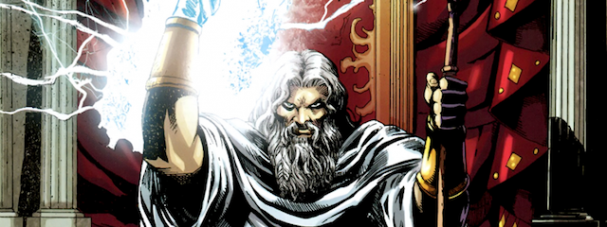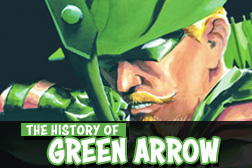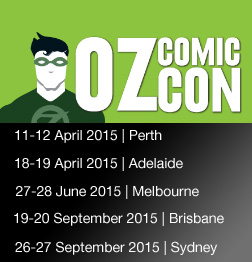Don’t have time for full reviews of comics? Then check out Graphic Bits: bite sized chunks of comic book goodness designed to get behind the panels and into your hearts.
Last week (4 September 2013) was a huge week for debut issues. Avengers maestro Jonathan Hickman determines God is Dead (Avatar), a plethora of writers and artists fill the return of Batman: Black and White #1 (DC Comics). Then Image Comics fires a one-shot in Love Stories to Die For and debuts Reality Check #1. This is Graphic Bits.
For the DC releases reviewed this week, check out that column we published earlier that includes reviews for Forever Evil #1, Justice League #23.1, Green Lantern #23.1, Green Arrow #23.1, Batman #23.1, Justice League Dark #23.1 and Justice League of America #7.1. In a second column, Marvel comes at us with not one but two events in X-Men: Battle of the Atom #1and Infinity #2, things get robotic in Avengers A.I. #3, while Jeff Lemire is back stops to smell the flowers in Trillium #2 (DC/Vertigo). Plus, our featured pick on the this week is The Star Wars: Lucas Draft #1 (Dark Horse).
God is Dead #1 – Avatar, Jonathan Hickman (writer), Mike Costa (artist). Rating: 5/10
 After mapping out the course of the entire Marvel universe(s) for the next few years, and creating an apocalypse over at Image Comics, it was only a matter of time before Jonathan Hickman set his eyes on destroying deities. Just as East of West brought the four horsemen of the apocalypse back to Earth, God is Dead ponders what would happen if the neglected old gods of the ancient Roman, Greek, Hinidi, pre-Columbian Americans and other legends returned to punish the non-believers. For reals. The fairly familiar notion is not tackled with any style or flair, and it is difficult to tell in this chaotically plotted first issue whether Hickman is trying for some higher calling or has simply cracked under the strain. There’s not even Hickman’s typical chapter headings to tell us what to do, so like a people without a religion, even the good book leaves us scratching our noggins. The central human figure and the underground movement of eggheads feels tacked on, as though it was borrowed from another concept and crammed in sideways. Most of this feels like an excuse for some blood, tits and mayhem Avatar style, presented in some fairly functional art from co-plotter Mike Costa. Best to let sleeping gods lie.
After mapping out the course of the entire Marvel universe(s) for the next few years, and creating an apocalypse over at Image Comics, it was only a matter of time before Jonathan Hickman set his eyes on destroying deities. Just as East of West brought the four horsemen of the apocalypse back to Earth, God is Dead ponders what would happen if the neglected old gods of the ancient Roman, Greek, Hinidi, pre-Columbian Americans and other legends returned to punish the non-believers. For reals. The fairly familiar notion is not tackled with any style or flair, and it is difficult to tell in this chaotically plotted first issue whether Hickman is trying for some higher calling or has simply cracked under the strain. There’s not even Hickman’s typical chapter headings to tell us what to do, so like a people without a religion, even the good book leaves us scratching our noggins. The central human figure and the underground movement of eggheads feels tacked on, as though it was borrowed from another concept and crammed in sideways. Most of this feels like an excuse for some blood, tits and mayhem Avatar style, presented in some fairly functional art from co-plotter Mike Costa. Best to let sleeping gods lie.
Batman: Black and White #1 – DC Comics, Chip Kidd, Neal Adams, Joseph A Quinones Jr., Maris Wicks, John Arcudi, Howard Mackie (writers), Michael Cho, Neal Adams, Joseph A Quinones Jr., Sean Murphy, Chris Samnee (artists). Rating: 10/10
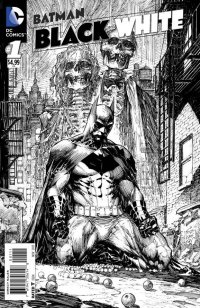 Of all the old concepts that DC has revived this week, Batman: Black and White has to be the best of them. While justice could barely be done in a capsule review, it is worth saying that there isn’t an ounce of fat on this, as DC assembles another wonderful collection of writers and artists.It kicks of with a Robin story by Batman: Death By Design writer Chip Kidd and “lost line” illustrator Michael Cho. It evokes a retro feel, which is then blind-sided by a surrealist piece by the legendary Neal Adams. A zombie Batman shuffles from scene to scene without any acknowledgement of his decaying state, literally unable to help those in need. Maris Wicks contributes a Harley Quinn/Poison Ivy story, with animated series inspired style from the wonderful Joe Quinones. Of course, it’s the Sean Murphy art on the John Arcudi script that rips through its chapter like a speed metal album, a perfect mix of style and adrenaline, as though summoning Sam Kieth’s The Maxx with a dash of manga for good measure. The final piece is the glorious union of Howard Mackie with current industry superstar Chris Samnee, the latter’s first turn on the Dark Knight. Even without Javier Rodriguez’s colours that typically accompany his Daredevil work, it’s a moody mixture of shadows and light, as if pulled straight from a film noir classic. Whether you get the single issues or wait for the collection, you will be getting this book.
Of all the old concepts that DC has revived this week, Batman: Black and White has to be the best of them. While justice could barely be done in a capsule review, it is worth saying that there isn’t an ounce of fat on this, as DC assembles another wonderful collection of writers and artists.It kicks of with a Robin story by Batman: Death By Design writer Chip Kidd and “lost line” illustrator Michael Cho. It evokes a retro feel, which is then blind-sided by a surrealist piece by the legendary Neal Adams. A zombie Batman shuffles from scene to scene without any acknowledgement of his decaying state, literally unable to help those in need. Maris Wicks contributes a Harley Quinn/Poison Ivy story, with animated series inspired style from the wonderful Joe Quinones. Of course, it’s the Sean Murphy art on the John Arcudi script that rips through its chapter like a speed metal album, a perfect mix of style and adrenaline, as though summoning Sam Kieth’s The Maxx with a dash of manga for good measure. The final piece is the glorious union of Howard Mackie with current industry superstar Chris Samnee, the latter’s first turn on the Dark Knight. Even without Javier Rodriguez’s colours that typically accompany his Daredevil work, it’s a moody mixture of shadows and light, as if pulled straight from a film noir classic. Whether you get the single issues or wait for the collection, you will be getting this book.
Love Stories to Die For #1 – Image Comics, Dirk Manning (writer), Rich Bonk, Owen Gieni (artists). Rating: 7/10
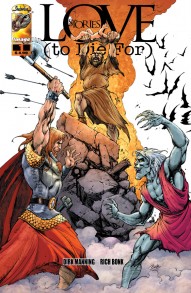 Think of the old anthology series like Creepy or Eerie and you will effortlessly slide into the vibe of this double feature one-shot from writer/creator Dirk Manning. A deuce of stories loosely around the notion of blending love and blood (they go together like a horse and…stud?), the first is a tale of some hard-travelling warriors who find themselves at a monastery, defending the clerics from the otherworldly creatures trying to storm the gates. However, it turns out that not everybody is telling the truth. Rich Bonk delights in carving chunks out of the undead in this appropriately sticky saga. The “other side” of the comic is a space-borne adventure in a ship that has been decimated by an encounter with aliens. Without needing to explain how or why, we witness the tragic tale of a man trying to return to the woman he loves. However, the audience already knows that her heart belongs elsewhere. Gieni’s art is something else, influenced by the European pages of the 1970s or even something we’d find in the now defunct anthology magazine 1984. It has a Ridley Scott vibe, but depicts a narrative that would exist parallel to his famous space thrillers. A surprisingly strong book, and we hope to see more of this from Image.
Think of the old anthology series like Creepy or Eerie and you will effortlessly slide into the vibe of this double feature one-shot from writer/creator Dirk Manning. A deuce of stories loosely around the notion of blending love and blood (they go together like a horse and…stud?), the first is a tale of some hard-travelling warriors who find themselves at a monastery, defending the clerics from the otherworldly creatures trying to storm the gates. However, it turns out that not everybody is telling the truth. Rich Bonk delights in carving chunks out of the undead in this appropriately sticky saga. The “other side” of the comic is a space-borne adventure in a ship that has been decimated by an encounter with aliens. Without needing to explain how or why, we witness the tragic tale of a man trying to return to the woman he loves. However, the audience already knows that her heart belongs elsewhere. Gieni’s art is something else, influenced by the European pages of the 1970s or even something we’d find in the now defunct anthology magazine 1984. It has a Ridley Scott vibe, but depicts a narrative that would exist parallel to his famous space thrillers. A surprisingly strong book, and we hope to see more of this from Image.
Reality Check #1 – Image Comics, Glen Brunswick (writer), Viktor Bogdanovic (artist). Rating: 7/10
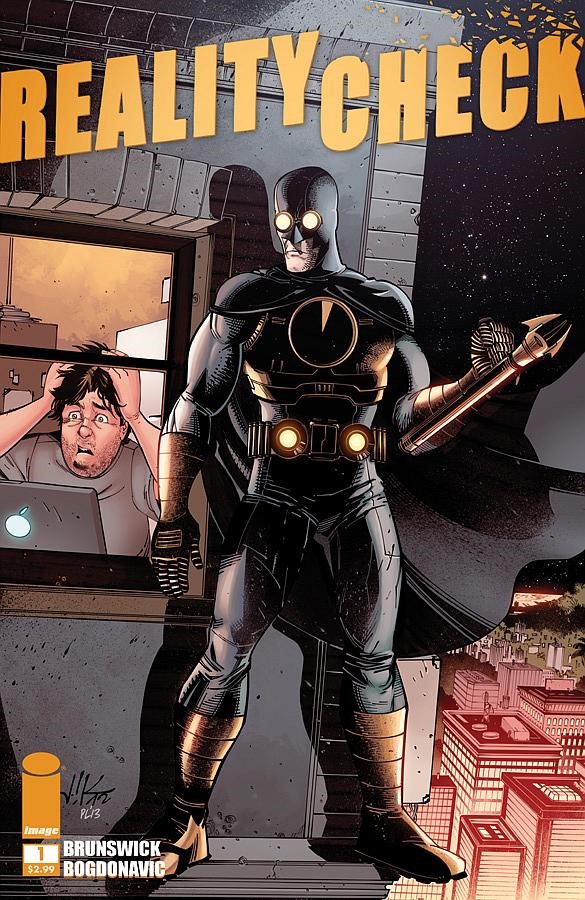 As comics get increasingly meta, we envisage a future in which the reader will have a comic written about them reading the issue that’s in their hands. In the meantime, Glen Brunswick writes an interesting spin on a comic creator who is writing something that isn’t very good. His story of a Batman clone (called Dark Hour) with romantic troubles is about to become a big hit when all of his work disappears from his computer, and well as his head. The reason for this becomes obvious when his creation comes to life (see: the cover of the comic), and this will presumably be the focus of the rest of the series. This issue, however, deals with protagonist Willard’s own attempts to catch a break, live in Los Angeles and speak to women. For half the aspiring comic creating readership, this will be either far too familiar or just the right level of geek familiarity. Brunswick doesn’t overdo the insider references, and Willard is a well rounded character. Bogdanovic crafts this plastic world of LA around him at an appropriate level, and his parallel comic within a comic is deliberately familiar and derivative. It will be interesting to see how this one pans out, as it could go either way from here. Definitely worth another look next month.
As comics get increasingly meta, we envisage a future in which the reader will have a comic written about them reading the issue that’s in their hands. In the meantime, Glen Brunswick writes an interesting spin on a comic creator who is writing something that isn’t very good. His story of a Batman clone (called Dark Hour) with romantic troubles is about to become a big hit when all of his work disappears from his computer, and well as his head. The reason for this becomes obvious when his creation comes to life (see: the cover of the comic), and this will presumably be the focus of the rest of the series. This issue, however, deals with protagonist Willard’s own attempts to catch a break, live in Los Angeles and speak to women. For half the aspiring comic creating readership, this will be either far too familiar or just the right level of geek familiarity. Brunswick doesn’t overdo the insider references, and Willard is a well rounded character. Bogdanovic crafts this plastic world of LA around him at an appropriate level, and his parallel comic within a comic is deliberately familiar and derivative. It will be interesting to see how this one pans out, as it could go either way from here. Definitely worth another look next month.
Agree or disagree? Got a comment? Start a conversation below, or take it with you on Behind the Panel’s Facebook and Twitter!
If you are an iTunes user, subscribe to our weekly podcast free here and please leave us feedback.

